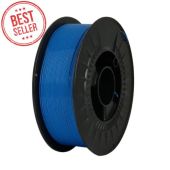TPU Bed Temperature: Optimal Range for 3D Prints
3D printing has evolved into an accessible technology for professionals, hobbyists, and engineers alike. At the heart of this process are the materials we use—from rigid PLA to tough ABS and flexible TPU. Each filament has its own requirements, and printing with TPU demands special attention due to its elastic nature.
Among the key parameters to control is bed temp. While TPU doesn't warp as easily as other materials, proper bed heat is still essential for achieving reliable first-layer adhesion. Get it wrong, and you'll face issues like poor grip, curling edges, or damaged parts.
Recommended Bed Temp Range
The ideal heated foundation temp for TPU is typically between 40 and 60°C. Some manufacturers and experienced users have reported success even at 30°C, but most recommendations fall in the 50–60°C range. Starting at around 50°C provides a safe baseline for testing your specific printer and filament combination.
Why It Matters
While TPU is known for being flexible and resistant to warping, the heated bed still plays a crucial role in ensuring reliable first-layer adhesion. A cold bed can cause poor adhesion, leading to curling edges or total print failure. On the other hand, an overheated bed might create too strong of a bond, making part removal difficult and potentially deforming the bottom layer.
The key is to find a moderate bed heat that helps the first layer grip the surface just enough without sticking too aggressively.
Surface & Adhesion Techniques
Your bed surface choice can drastically impact your printing success. A glass bed with a thin layer of glue stick offers an optimal mix of adhesion and ease of removal. The glue acts as a release agent when cooled, preventing parts from bonding too strongly.
Some users apply painter’s tape, but this tends to wear out quickly with flexible filaments and may need frequent replacement. Surfaces like PEI or BuildTak offer strong adhesion and can work with TPU, but only if you're experienced in print removal techniques—otherwise, you risk damaging the print or bed.
Filament and Printer Differences
There is no single "correct" bed heat setting for all situations. Your results will vary depending on:
- The TPU brand or type, especially Shore hardness and whether additives are present
- Your printer model, including its heated bed capabilities
- The bed surface material and any adhesives used
- Ambient room temp and humidity levels
Starting within the 40–60°C range is ideal, but expect to tweak settings slightly based on how your prints perform. Adjust in small increments and observe the first-layer behavior.
Comparison with Other Materials
Compared to other popular filaments:
- TPU shares a similar build plate heat range with PLA (30–60°C)
- ABS and Nylon require much higher surface temperatures due to severe warping (80–100°C)
- TPU's low warping nature makes it less demanding in terms of bed heat, but adhesion is still important
Using a modest platform temperature with TPU gives you enough grip without the warping risks that come with materials like ABS.
Community Insights & Practical Tips
From community feedback, most TPU issues arise from extrusion difficulties or stringing, rather than adhesion problems.
If you're getting strings or blobs, lowering your nozzle temp slightly can help clean up the print without compromising layer grip, provided the bed is warm enough.
Once you've dialed in the correct surface temperature, focus on tuning retraction settings and print speed to improve overall print quality. Adhesion is only one piece of the puzzle.
TPU Filaments at 3DTrcek
3DTrcek offers a wide selection of 3D printing filaments, including professional-grade TPU options. These filaments are engineered for projects that need high flexibility, strong impact resistance, and lasting durability.
Whether you're prototyping shock-absorbing parts, creating flexible hinges, printing phone cases, or designing custom gaskets, 3DTrcek TPU and TPU CF FLEX filaments deliver consistent performance across all major FDM 3D printers.
Each spool is quality-tested to ensure smooth extrusion and dependable bed adhesion in real-world conditions. This makes them an ideal choice not just for hobbyists, but also for small businesses and industrial prototyping applications.
Final Thoughts
Dialing in the right TPU bed temp is a small but crucial step in producing successful flexible prints. Use the 40–60°C range as a starting point, pay attention to your specific setup, and be ready to fine-tune.
Once adhesion is handled, you'll be free to explore TPU's full potential with confidence.
For reliable filaments, tips, and professional guidance, visit 3DTrcek and explore their range of flexible materials and printing accessories.
; ?>) Shop TPU Filament
Shop TPU Filament


Please complete your information below to login.
Prijava
Kreiraj novi račun